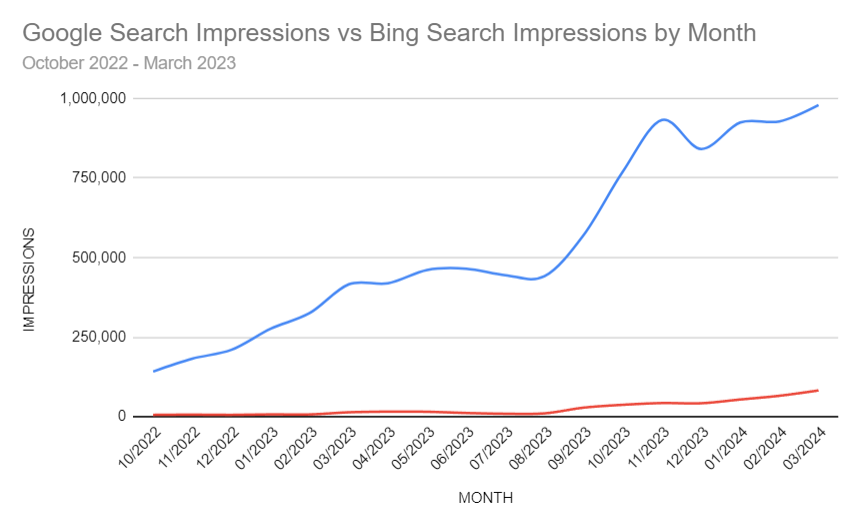Bing's Rising Tide: Why It's Becoming a Key Player in My Traffic Growth Strategy
There has been talk over the past several months about how Bing has made some small, yet consistent gains on Google’s dominant share of the search market. While Google has long been the titan of traffic for my website, recent data from my analytics reveals an interesting trend that is prompting me to pay closer attention to the underdog: Bing.
A Closer Look at the Data
I first signed up for Bing Webmaster Tools in October 2022, so that is my starting point looking at the data. Since October 2022, the search impressions on my website from Google and Bing have told a story of growth and dominance. Google, as expected, continues to drive a substantial volume of traffic to my site, thanks to monthly impressions averaging around 540,566, which recent months almost reaching one million impressions. In the graph below, even though the line for Bing (shown in red) is not as prominent as the Google line (shown in blue), it's Bing that steals the spotlight with a staggering growth rate. Since October 2022, my Bing search impressions have grown by approximately 1,278%, compared to Google's (still really impressive) 589%. This rapid growth, although from a smaller base, signals Bing's expanding influence and potential as a significant traffic source for my site.
Google: The Unyielding Leader
Google's long standing dominance in the SEO landscape is undeniable. My personal data underscores its role as a primary driver of search traffic to my blog. With high month-to-month growth rates indicating its vast reach and impact, Google's platform remains the cornerstone of any robust SEO strategy, including my own. Strategies to optimize for Google, such as focusing on high-quality content, using relevant keywords, and enhancing site speed, continue to be essential. After all, whenever Google does an update, we all pay attention. But we don’t do that for Bing. But this recent data is making me reconsider that approach.
Bing: The Rising Contender
The narrative shifts when I consider Bing's exponential growth rate over the last 18 months for my site. Despite its smaller overall impression count, Bing's rapid increase suggests a growing user base that could be more engaged than originally anticipated. Optimizing for Bing, I have decided, should not be an afterthought. This includes leveraging Bing Webmaster Tools more, ensuring that my site is Bing-friendly with clear navigation, and possibly even exploring Bing-specific ad opportunities to maximize visibility.
It should also be noted that my target audience is business professionals, many who might be required to use Bing at work due to corporate IT controls (Note: most of my traffic comes during normal working hours and is overwhelmingly from desktop/laptop devices) which makes it even more important that Bing be a significant part of my SEO strategy.
Integrating Insights into Strategy
The differing dynamics of Google (the volume driver) and Bing (the growth driver) point to the necessity of a dual-focused approach in SEO strategies. Therefore, here is the high-level approach I am taking.
Google Optimization: Continue to prioritize Google but refine my strategies to maintain and grow my presence. This includes regular updates to content, improving user engagement, and continue keeping my content helpful.
Bing Optimization: Given its growth trajectory, increasing efforts on Bing might provide competitive advantages. This might involve adjusting technical SEO practices to better align with Bing’s ranking algorithms and exploring lesser-used features like rich media and structured data to enhance visibility.
Final Thoughts
While Google remains the leader of the two in terms of visibility of my site in search results, Bing's rapid ascent in the data suggests that a singular focus on Google might mean missing out on valuable traffic and engagement opportunities. By adopting a balanced and responsive SEO strategy that includes both search engines, I am hoping I can maximize my digital footprint and reach broader audiences more effectively, and most important, diversify my traffic.
